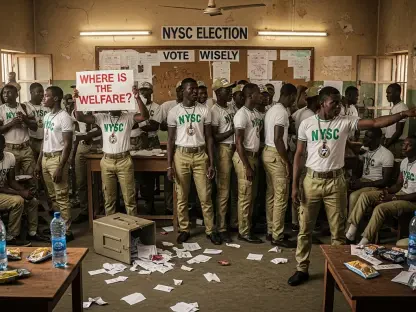In the electrifying realm of rock and roll, aging legends like AC/DC continue to reign supreme, their recent Melbourne performance sending literal shockwaves through the earth with seismic vibrations detected from fan energy and booming speakers. These heritage acts, often in their 70s or older, pack stadiums worldwide, drawing crowds that younger artists struggle to match, yet their advancing years cast a shadow over the live music industry with unprecedented challenges. Insuring these cultural icons goes far beyond safeguarding a single concert; it involves protecting a legacy while navigating a maze of personal health risks and sprawling logistical concerns. The stakes are high as insurers grapple with balancing the immense commercial value of these performers against the vulnerabilities that age inevitably brings. This exploration delves into the intricate underwriting landscape, shedding light on how the industry adapts to ensure that rock’s titans can keep rolling without financial or operational collapse.
Unraveling the Actuarial Enigma of Veteran Performers
The core challenge in insuring rock’s aging giants lies in the personal risks tied to their health, a reality brought into sharp focus by events like AC/DC’s earth-shaking Melbourne show with Brian Johnson at 78 and Angus Young at 70, alongside the somber passing of Ozzy Osbourne. Insurers must solve a complex actuarial puzzle: how to underwrite artists whose physical condition could lead to sudden cancellations or tragic outcomes while their ability to draw massive audiences remains unmatched. Industry voices, such as Mark Hynds of Rokstone and Tim Thornhill of Tysers, underscore the critical need for meticulous medical underwriting to evaluate and price these risks with precision. Their insights reveal a pressing concern—ensuring that the cultural and economic weight of these performers doesn’t tip the scales into unmanageable financial exposure. The task is to craft policies that protect both the artists and the industry, maintaining a delicate equilibrium in a high-stakes environment where every tour could be a final encore.
Beyond the spotlight, the actuarial challenge extends to understanding the unique vulnerabilities of older performers whose careers span decades. Unlike younger artists who may face fewer health hurdles, these rock legends often carry a history of wear and tear from years on the road, compounded by age-related conditions that could derail a tour at any moment. Hynds emphasizes that fairness in pricing is paramount, cautioning against burdening newer generations of musicians with inflated premiums to cover the heightened risks of their elders. Meanwhile, Thornhill points to the necessity of adapting underwriting practices to account for the unpredictable nature of health issues in this demographic. This approach ensures that insurers are not caught off guard by sudden claims, while also preserving the viability of tours that generate millions in revenue and sustain countless jobs in the live music ecosystem. The balance of risk and reward has never been more critical as these icons continue to defy time on stage.
Medical Assessments as the Bedrock of Risk Management
Delving into the specifics of risk evaluation, medical underwriting emerges as an indispensable tool for insuring aging rock stars, setting a stark contrast to the simpler health declarations often sufficient for younger bands. For veteran performers, comprehensive medical evaluations are frequently required to uncover pre-existing conditions that could jeopardize a tour, providing insurers with a clearer picture of potential liabilities. Hynds argues passionately for a system where premiums are directly tied to individual risk profiles, preventing younger artists from subsidizing the higher costs associated with older acts through disproportionate charges. This tailored approach aims to maintain equity across the industry, ensuring that each performer’s policy reflects their unique health challenges rather than a one-size-fits-all model. Such precision in assessment is vital to sustaining trust between insurers, artists, and promoters in an environment where a single health scare can halt a multimillion-dollar production.
Moreover, the emphasis on detailed medical assessments highlights a broader shift toward data-driven decision-making in the insurance landscape for live music events. Thornhill reinforces the importance of customizing evaluations, noting that the depth of medical scrutiny often correlates with the age and health history of the artist, ensuring coverage aligns with the specific risks they present. This process not only protects insurers from unexpected claims but also offers artists and their teams a transparent understanding of the costs involved in securing their performances. As tours grow in scale and complexity, the reliance on thorough health checks becomes a safeguard against the financial fallout of cancellations or emergencies. This rigorous approach underscores a commitment to sustainability, allowing the industry to support aging performers without compromising the economic stability of the broader insurance pool. The result is a framework that respects the legacy of rock icons while addressing the harsh realities of their physical limits.
Navigating Logistical and Environmental Hazards
The risks of insuring rock’s aging giants extend far beyond personal health, encompassing a wide array of logistical and environmental challenges inherent in modern stadium tours, as vividly illustrated by AC/DC’s Melbourne performance that triggered earthquake detection systems with its sheer intensity. The raw power of fan enthusiasm combined with massive sound equipment introduces physical dangers that insurers must account for, from structural strain on venues to the potential for weather-related disruptions. Thornhill identifies event cancellations due to adverse conditions or venue unavailability as a primary concern, noting that such incidents can lead to significant financial losses for promoters and artists alike. These external factors add a layer of unpredictability to underwriting, requiring policies that cover not just the performers but the entire ecosystem of a tour, ensuring that a sudden storm or technical failure doesn’t spell disaster for all involved.
Additionally, the scale of today’s live events amplifies the complexity of managing these external risks, pushing insurers to adopt a more holistic view of coverage. The seismic impact of a show like AC/DC’s serves as a stark reminder that modern productions are feats of engineering as much as artistry, with potential hazards lurking in every corner of a stadium setup. From electrical failures to crowd control issues, the scope of potential disruptions demands comprehensive risk assessments that go beyond traditional artist-focused policies. Insurers must collaborate with venue operators and event planners to mitigate these dangers, crafting solutions that anticipate a range of scenarios and protect against cascading financial impacts. This broader perspective is essential in an era where the spectacle of a rock concert rivals the complexity of a major infrastructure project, ensuring that the thrill of the performance isn’t overshadowed by the threat of unforeseen calamities.
Weighing Self-Insurance Against Traditional Protection
A pivotal discussion in the industry centers on the choice between self-insurance and traditional coverage for aging rock acts, a decision that carries significant financial implications for tours often costing tens of millions upfront. Hynds offers a compelling caution against self-insurance, likening major tours to small businesses that cannot withstand the catastrophic loss of a single event without a safety net, arguing that many shows simply wouldn’t proceed without the backing of robust insurance policies. This perspective highlights the indispensable role of insurers in enabling the live music industry to thrive, providing a buffer against the unpredictable nature of live performances where a single cancellation can erase months of planning and investment. The financial stakes underscore the need for a structured approach to risk management, ensuring that the cultural contributions of these artists aren’t jeopardized by fiscal vulnerabilities.
On the other hand, some older artists explore alternatives to manage premium costs, revealing a nuanced negotiation of risk and reward within the industry. Thornhill points out that certain heritage acts opt for higher deductibles—such as covering the losses of the first two shows in a 15-show tour—to reduce the immediate burden of insurance expenses while still maintaining a level of protection. This strategy reflects a calculated gamble, balancing the desire to lower costs with the reality of potential disruptions, and illustrates the diverse approaches artists take based on their financial capacity and risk tolerance. Such arrangements require careful calibration by insurers to ensure that deductibles and exclusions align with the actual exposures of a tour, preventing gaps in coverage that could prove disastrous. This flexibility in policy design is a testament to the evolving nature of insurance solutions, adapting to the unique needs of rock’s enduring legends as they navigate the twilight of their careers.
The Unmatched Draw of Heritage Bands
Despite the passage of time, heritage bands maintain an unrivaled grip on the live music scene, consistently filling stadiums and outshining newer generations of performers, which in turn fuels a persistent demand for specialized insurance solutions. This enduring popularity is a testament to the cultural resonance of acts like AC/DC, whose shows remain must-see events for fans across demographics, driving ticket sales and revenue streams that few contemporary artists can rival. The commercial dominance of these icons places immense pressure on insurers to develop policies that accommodate their heightened risk profiles while supporting the industry’s reliance on their draw. Hynds and Thornhill converge on the necessity of disciplined underwriting practices, rooted in transparent data and thorough risk assessments, to meet this demand without destabilizing the insurance market. Their consensus points to a future where adaptability and fairness define the approach to covering rock’s stalwarts.
Furthermore, the sustained success of these veteran acts reveals a deeper trend within the live music ecosystem, where nostalgia and legacy play as significant a role as innovation in shaping audience preferences. Insurers must recognize that the value of insuring an aging rock star extends beyond mere financial metrics; it encompasses the preservation of a cultural phenomenon that continues to inspire and unite generations. This dynamic necessitates a forward-thinking mindset, where policies are crafted not just to mitigate risks but to enable these artists to perform as long as their fans demand it. The challenge lies in ensuring that premiums remain sustainable, avoiding the pitfall of overpricing that could deter smaller tours or younger acts from securing necessary coverage. By striking this balance, the industry can honor the contributions of rock’s giants while fostering an environment where live music, in all its forms, continues to flourish as a vital artistic and economic force.
Adapting to Escalating Complexities in Live Events
The landscape of live events has evolved dramatically, with modern tours becoming colossal productions that transcend a simple band performance, introducing escalating risks that insurers must navigate with innovative strategies. AC/DC’s seismic Melbourne show exemplifies this shift, where the sheer scale of production—combining massive sound systems, intricate staging, and thousands of fans—creates physical exposures that rival major industrial projects in complexity. These factors demand a wider scope of coverage, extending beyond artist health to include venue integrity, equipment failures, and environmental disruptions. Thornhill notes that such multifaceted risks require insurers to adopt a more comprehensive approach, ensuring policies address the full spectrum of potential issues that could derail a tour. This evolution signals a critical need for adaptability, as underwriters grapple with scenarios that were unimaginable in the simpler concert formats of decades past.
In parallel, the maturation of the insurance sector offers a glimmer of hope amid these growing complexities, driven by technological advancements and heightened accountability over recent years. Tools for risk rating and data analysis have become more sophisticated, allowing insurers to refine pricing models and better predict potential claims, a development that Hynds highlights as a sign of progress in achieving sustainability. Yet, challenges persist, particularly in aligning coverage with the intricate contractual obligations between artists, promoters, and venues, ensuring that no party is left exposed to undue risk. This ongoing refinement of underwriting practices is crucial as live events continue to push boundaries in scale and ambition. By leveraging better data and fostering collaboration across stakeholders, the industry can build a resilient framework that supports the grandeur of modern rock tours while safeguarding against the myriad hazards they present.
Sustaining the Legacy Through Strategic Solutions
Reflecting on the journey of insuring rock’s aging giants, it becomes evident that the industry stands at a pivotal moment, balancing the cultural weight of these legends against the mounting risks their performances entail. Expert perspectives from figures like Hynds and Thornhill illuminate a shared commitment to disciplined underwriting, where medical precision and transparent pricing form the bedrock of sustainable practices. Their insights underscore how insurance acts as the unseen backbone of live music, enabling seismic events like AC/DC’s Melbourne spectacle to captivate audiences without financial ruin looming overhead. Looking ahead, the path forward hinges on embracing technological tools to enhance risk assessment, crafting customized policies with flexible deductibles, and fostering collaboration among artists, promoters, and venues to address logistical challenges. These strategic steps promise to preserve the enduring legacy of rock’s titans, ensuring their music echoes through stadiums for as long as fans clamor for one more encore.









